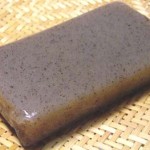The Non-miracle of Miracle Noodle
 In the seemingly never-ending quest for the Magic Bullet of well-being that alleviates anybody from any responsibility for their nutritional intake, I bring you something that the Japanese call “konnyaku”. In North America, you may be familiar with a closely-related derivative known by the brand name of Miracle Noodle.
In the seemingly never-ending quest for the Magic Bullet of well-being that alleviates anybody from any responsibility for their nutritional intake, I bring you something that the Japanese call “konnyaku”. In North America, you may be familiar with a closely-related derivative known by the brand name of Miracle Noodle.
If you do a Google search for konnyaku, you’ll be inundated with web sites claiming that this is a highly prized culinary delicacy with nothing less than superpowers to magically keep down the calories and improve health. What’s the truth here? Is it possible that the Magic Bullet does, indeed, exist?
The short answer is: No. The longer answer is a little more complex, but you’ll soon see that this, like so many other wonder cures for calorie consumption, is no panacea. So, what’s the problem?
First off, Miracle Noodle isn’t konnyaku. A cursory look at the list of ingredients gives us: Water, glucomannan (soluble fiber), calcium additive. In other words, this isn’t the ground up roots of the konnyaku plant, this is the equivalent of an extract. It’s 100% processed food, plain and simple.
A subsequent look at the nutritional values gives us 0 calories. Whoa, that’s cool, right? Uhm. Well, yeah, but I can get zero calories out of eating broken glass or tin cans (assuming I’ve washed all the food off of them). Why would pure fibre without any caloric value be good for you?
It’s often touted that glucomannan aids in sugar control and other health benefits. The problem here is that it’s virtually indigestible, so while it may “hoover” up all sorts of moisture, sugars and other stuff that it finds in your stomach, it also sucks up other nutrients that you need. This is a bathwater and the baby scenario. It doesn’t just suck up unwanted calories, it sucks up wanted calories, too.
Before you bring up the presence of potassium, zinc, calcium, etc. in konnyaku, I need to remind you that this is in ground root flour. Glucomannan has none of these nutrients. And, even if it did, since it passes through you virtually undigested, any of the nutrients would be barely bio-available anyway.
So, as always, the point of the matter is that when you’re dealing with processed foods, you’re not getting the goodness your body so properly expects and so richly deserves. Rather than looking to non-calorie stomach fillers as the answer to weight loss, focus instead on a complete diet based on whole foods.
It’s not rocket science. Eat right. Eat whole. Eat raw.



September 23, 2018 at 10:08 pm
Mike
Prebiotics are 0-calorie and glucomannan is prebiotic isn’t it?
April 5, 2016 at 10:14 am
Reed Baxter
Totally disagree. If you are on a very low calorie diet this is awesome stuff. How can a 0 calorie noodle be unhealthy when all the fattycakes out here are gorging themselves on fast food? Cuz there’s so many useful nutrients in that! Always has to be a fun sucker amongst the crowd.
April 5, 2016 at 10:33 am
Trane Francks
Well, Reed, you’re free to disagree, but that doesn’t make you right. One of the ingredients of Miracle Noodle is calcium hydroxide. The body has a very difficult time with synthetic calcium and there are contraindications with regard to intake of calcium-only supplements. Moreover 0-calorie isn’t something that is essentially good.
With regard to fast food, there is an incredibly low amount of useful nutrients present. Most fast foods are so heavily processed that essential minerals and nutrients are in short supply. They are then heavily loaded with sugars, NaCl (table salt), artificial flavours, novel chemicals and harmful preservatives.
Natural, whole, healthful foods are the answer. Not the Diet Fad of the Week.
Cheers!
March 9, 2011 at 12:24 am
Amy
Food for thought, no pun attended. Although I can understand the detriment of using this as the only food source to lose weight, however knowing most Americans are not missing the daily amount of calories, nutrients (usually doubling or more in consumption of the recommended requirements) This may not play a horrible role. Yes, the responsibility to be concerned of eating right and excercise will always lead to a heathier lifestyle (as well as Mind and Soul) but the increasing sedentary lifestyle that has developed in our Society and the increasing demands for more time and stress wreaks havoc on the utopian idea of taking the time to make our meals from scratch or one better harvest from our urban gardens – create a healthy dinner – exercise and all around enjoyment of family and friends. Education is Key but judgement is not the way.
March 9, 2011 at 7:02 am
Trane Francks
Hi, Amy.
Thanks for sharing your thoughts here!
Unfortunately, North Americans enjoy the awkward combination of too many calories and not enough vitamins and nutrients. And the proof of this lay squarely in the norm for the vast majority of the population to be unwell, even though the natural state of the body is complete well-being. In fact, it’s been shown in quite a few studies that the typical 2000-2500 calorie “requirement” is likely on the heavy side and that the body actually thrives on a moderately calorie-restricted diet.
I’d say that our health trends are a warning against looking for a quick fix. We North Americans have shown an increasing tendency towards instant gratification over the last 100 years, indicated by everything from fast food restaurants booming in society to the demands of shareholders for short-term profits over a long-term strategy. These aren’t complaints, they’re merely observations.
Culturally, Western culture is in an interesting situation with regard to quality. We seem to be more quantity-driven, and as a result, we’re moving away from moderation and towards extremes. Unless that changes, our healthcare systems will continue to be overburdened. You were right on the money with the “time and stress” comment.
Welcome to the site. I hope you share your thoughts again in the future. 🙂
February 27, 2011 at 1:56 pm
jelena
Hi
That noodle thing on this picture looks like scrub – soap, no wonder it’s indigestible.
February 27, 2011 at 2:05 pm
Trane Francks
I confess that I’ve eaten a fair bit of konnyaku since I came to Japan 20 years ago, but it really does just pass through you unscathed. The consistency is like stiff jelly, and it has basically no taste whatsoever. Weird stuff.
I worry that people who eat this as a way of losing weight will sacrifice nutrition. That’s a lose-lose scenario.